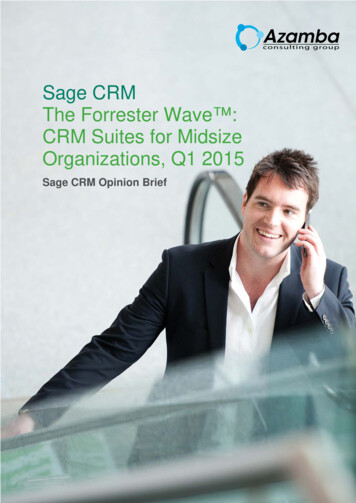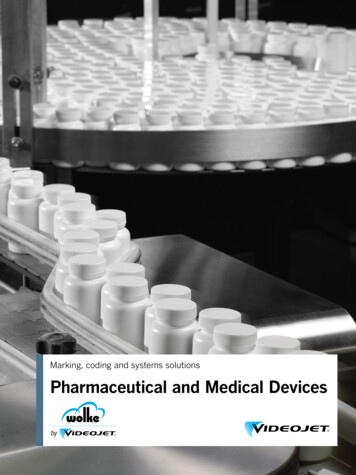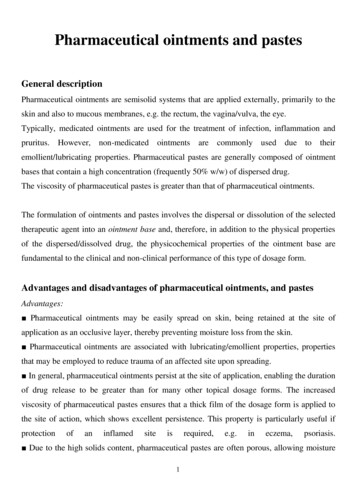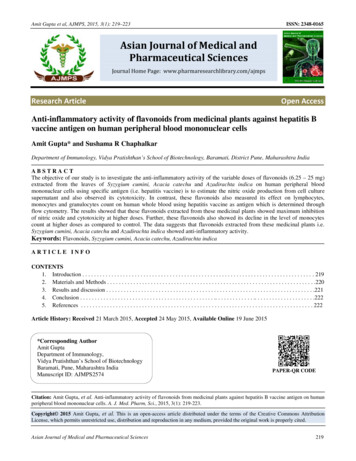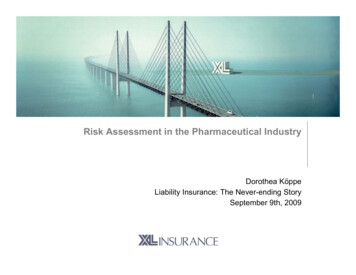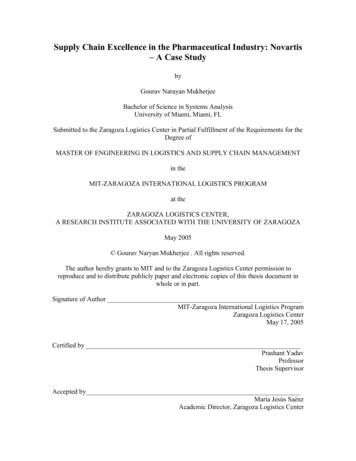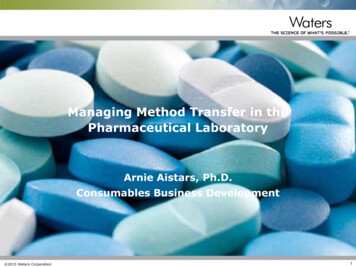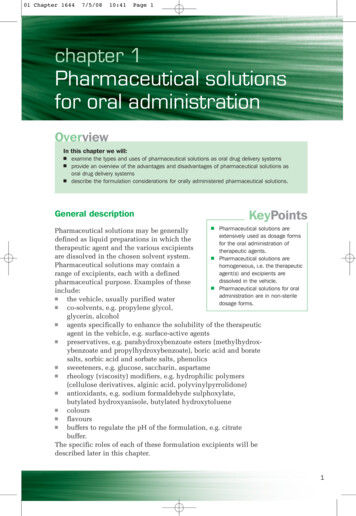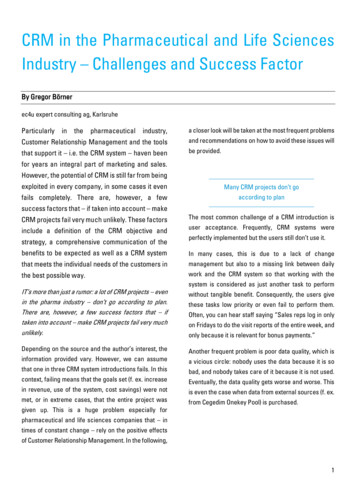
Transcription
CRM in the Pharmaceutical and Life SciencesIndustry – Challenges and Success FactorBy Gregor Börnerec4u expert consulting ag, Karlsruhepharmaceutical industry,a closer look will be taken at the most frequent problemsCustomer Relationship Management and the toolsand recommendations on how to avoid these issues willthat support it – i.e. the CRM system – haven beenbe provided.Particularly in thefor years an integral part of marketing and sales.However, the potential of CRM is still far from beingexploited in every company, in some cases it evenMany CRM projects don’t gofails completely. There are, however, a fewaccording to plansuccess factors that – if taken into account – makeCRM projects fail very much unlikely. These factorsinclude a definition of the CRM objective andstrategy, a comprehensive communication of theThe most common challenge of a CRM introduction isuser acceptance. Frequently, CRM systems wereperfectly implemented but the users still don’t use it.benefits to be expected as well as a CRM systemIn many cases, this is due to a lack of changethat meets the individual needs of the customers inmanagement but also to a missing link between dailythe best possible way.work and the CRM system so that working with theIT’s more than just a rumor: a lot of CRM projects – evenin the pharma industry – don’t go according to plan.There are, however, a few success factors that – iftaken into account – make CRM projects fail very muchunlikely.Depending on the source and the author’s interest, theinformation provided vary. However, we can assumethat one in three CRM system introductions fails. In thiscontext, failing means that the goals set (f. ex. increasein revenue, use of the system, cost savings) were notmet, or in extreme cases, that the entire project wasgiven up. This is a huge problem especially forsystem is considered as just another task to performwithout tangible benefit. Consequently, the users givethese tasks low priority or even fail to perform them.Often, you can hear staff saying “Sales reps log in onlyon Fridays to do the visit reports of the entire week, andonly because it is relevant for bonus payments.”Another frequent problem is poor data quality, which isa vicious circle: nobody uses the data because it is sobad, and nobody takes care of it because it is not used.Eventually, the data quality gets worse and worse. Thisis even the case when data from external sources (f. ex.from Cegedim Onekey Pool) is purchased.pharmaceutical and life sciences companies that – intimes of constant change – rely on the positive effectsof Customer Relationship Management. In the following,1
THE AUTHORThe benefit of a CRM system isundisputableIt is, however, indisputable that CRM and a supportingCRM system can provide a significant contribution to thesuccess of every company. The benefit is twofold:increase in revenue and cost savings.Increase in revenueCRM uses various leverages to generate more revenue.A better understanding and development of existingcustomers can result in improved up-selling and crossselling, increased success rates of offerings, higherGregor Börner is Principal Consultant with ec4u expert consulting agreselling rates, more recommendations as well as lowerin Karlsruhe. In this role, he consults companies primarily from theprice sensitivity of the customers. This can be achieved,pharmaceutical and life sciences industries in all matters regardingCRM. His focus is placed on the strategic and technical questions ofa CRM implementation. Moreover, he takes care of ec4u’spharmacrm blog.among other things, through a better alignment of allcustomer channels. Thanks to structured marketdevelopment, higher lead rates can be achieved, andmore leads will eventually converted into buyers.In these cases, that extends to the type data in the CRMsystem that sales reps need to collect.Cost savingsThis increase in revenue, however, will not be reachedthrough higher costs. A functioning CRM system ratherCustomer Relationship Management (CRM)helps reducing costs. Cost savings are achievedCRM is an approach of supporting customers in athrough lower process costs (less coordination etc.),structured way and to develop long-term andless administration efforts, lower divergence losses insustainable relationships with the clients.sales and marketing and an increase of the self-serviceCRM SystemA CRM system is a technical tool that supports CRMprocesses. Based on a customer or lead database, thesystem provides the data and tools needed for CRM.level of employees and customers. Considering the highshare of marketing and sales cost of pharmaceuticalcompanies, it becomes evident how powerful thisleverage can be.Let’s put it like this: CRM means doing the right thing(effectiveness) in the right way (efficiency) to increaseAll these issues will eventually result in the CRM systemrevenue. The benefit has become evident now, but howfailing to provide the benefits expected by the companycan you make sure a CRM project becomes a success?that introduced it.2
because everyday reality, experience for a long time, isThe four success factors of CRMdocumented and reviewed for the first time ever. ThisFrom my project experience, there are four aspects thatyou need to consider when introducing a CRM system:CRM strategy, processes and structures, technology aswell as employees and corporate culture.effort, however, will eventually pay off: only when allCRM relevant processes are thoroughly documentedand reviewed and match the CRM strategy, the rightCRM system can be chosen to support the processes.TechnologyCRM StrategyNo CRM project and no CRM system implementation willever be successful without defining beforehand whatyou want to achieve (CRM objective) and how you intentto achieve it (CRM strategy). This has to be donebecause a) without knowing where you want to go youcannot measure if you achieved your goal, and b) inorder to have guiding principles for the implementationof the CRM strategy into processes, the system, andwith the employees.The CRM strategy of a pharmaceutical company, forOnce the processes are defined, it’s time to determineCRM system requirements based on the processes(“Which are the situations and processes we needtechnical support in?”) and to match these requirementswith the offerings of the CRM system providers in themarket. Only a (customized) system that meets therequirements in the best possible way can deliver cal industry will be described later.Illustration 1instances, answers the question what the companyseeks to achieve with which customers. For example, itanswers the question if OTC companies generaterevenue from OTX prescriptions from doctors orrecommendations made by pharmacies (“What do wewant to achieve?”). This is also where decisions abouthowpharmacyrecommendationsaremade(commercial vs. scientific argumentation: “How do wewant to achieve our goals?”). This decision does notinvolve a specific CRM system, it is, however, the basisfor the following steps.Processes and structuresOnce the CRM strategy is defined, the next step is todescribe the business processes needed to implementthe strategy. Questions may include: What is an idealvisit to a doctor (plan, prepare, do and follow-up)? Whatare the steps and who is responsible? This is not themoment to talk about a specific technology yet: at thispoint of time, marketing, service and sales need todefine what customer touch points have to be like toachieve the defined goals.This second element of the processes is the one thatCRM success factors (source: all illustrations were created by theauthor)Employees and cultureThe issue of employees and corporate culture is oftenforgotten or not taken care of because it is less tangible.Without the employees being involved and havingunderstood the benefit, and without a bonus systemconsistent with the CRM goals, the CRM introductionrequires the highest amount of work in a CRM project3
will not succeed. Change management will be coveredThere is hardly any other industry with such complexlater in this article.delivery schemes for goods that, in part, cost less thanIt has become evident that the introduction of a CRMsystem is more than just switching on a piece of10 . This construct is defined and stabilized by a largenumber of laws and regulations that need to beconsidered when in contact with the customer. Ansoftware.example is the increasingly complex regulationregarding the supply of samples for physicians (FSACharacteristics of thepharmaceutical industryCode of Conduct).Furthermore, there are unique data sources (f. ex.regional segment/brick level data or the OneKey Pool)Each industry has its peculiarities with regard toand requirements such as mobile (efficient use theCustomer Relationship Management. When selectingwaiting time) and offline use in the hospital.the right CRM solution, it is therefore essential to havethese peculiarities reflected in the system. This willincrease user acceptance and decrease (if alreadyavailable out of the box) the implementation effort.A pharma CRM system should not only fulfill thecompany-specific requirements but be able to handlegeneral pharma requirements out of the box. Mappingthese functionalities at the beginning and keeping themIn the pharmaceutical industry – with its extensiveup-to-date would require a significant amount of extraexperience in optimizing market development – one ofwork. From the large number of CRM vendors, a smallthe biggest challenges in customer development is thegroup has emerged that especially focuses on pharmadifferentiation between decider, payer, user andCRM.supplier and the resulting political restrictionsIllustration 2Scheme of a Rx prescription4
Best practicesYou may be wondering how to successfully implement aproject considering all pharma requirements and theChecklist: Here is what the management should knowbefore the implementation rather a supporting tool.success factors mentioned above. In my opinion, astructured procedure is the best way to succeed (seeA CRM system is not a problem-solving tool, but There is no perfect solution, but the morefunctionalities the better it is.fig. 3).The key is: strategy first, then the requirements and then using and backing the system.the appropriate technology. On this basis, the decisionfor the right system can be made. Along with changemanagement, the system can then be introduced and There will be more spending than just license andacquisition cost.XY will solve all our issues.”) or taking the CRM goal(“We will have to take care of key opinion leaders.”) asThere has to be a “business owner”, IT alonecannot operate a CRM system.operated.The immediate decision for a specific system (“SystemThe management must serve as a role model in Each system introduction has high initial costs.a decision basis for the system (“We best do that withsystem XY.”) will fail in most cases because thebusiness reality is not entirely considered and notcovered by the system.Change managementBeside the CRM strategy, change management shouldnot be neglected. Eventually, it is the users who willhave to use the CRM system. This can only be achievedif the following aspects – essential for implementingchange – are considered.Illustration 3Best practices: CRM introduction5
There is no reason not to use the systemthemselves do not benefit from it. This perception isThe main risk of each CRM introduction are technicalwidely spread – especially in the pharmaceuticalproblems. When these issues occur while the system isindustry. However, this endeavor would be quiteintroduced, that will give reluctant or uncertain users asenseless because first, it does not serve the idea ofreason to ditch the system (“It doesn’t work!”).CRM and second, its benefits would be limited to someTherefore, you have to make sure that the systemslight KPI improvements in employee performance.provides no reasons not to use it.Obviously, this minor enhancement would not be Bad data quality (“I can find none of mycustomers!”) enough considering the high costs of a CRM projects. Itis therefore essential to plan the benefit for theorganization and its employees, and to activelyComplex access (“First I need to sign in my PC, thencommunicate it from the very beginning. Without thein VPN and then in the CRM system. That takes 20users recognizing benefits in the medium term, no CRMminutes. And if I forget my password, it takes twosystem will ever become a success.days to reset it.”)Reasons for using the system: role modelsEven when all the hurdles are removed and the benefit Lack of usability (“I don’t understand the system.”) Missing processes/functionalities (“I still have toto use the system will do so. Therefore, role models thatdocument the sample distribution by hand, so whyhave realized the benefit and show the other employeesdo I need the CRM system?”)how much time they can save or how much they canis recognized, not all the employees that are supposed Slow system/bad response times (“It takes ages toperform X.”) No training (“I have no idea how to do that.”)But even when all hurdles are removed in the bestpossible way, no user will start using it right away.increase their sales performance play an important role.It is of course helpful if these employees are advocatesof the CRM approach – often they are pilot or superusers. Alternatively, the management can assume thisrole and serve as a good example documenting forexample all customer contacts in the CRM system undsending no more emails that contain results or follow-upReasons for using the system: recognized benefitsactivities.“Without the users recognizing benefits in the mediumExampleterm, no CRM system will ever be successful.”CRM introduction in the pharmaceutical industry, salesSystem acceptance is primarily based on understandingwhy one should use it, i.e. being aware of the benefitsthe company and the users themselves will have. Thebenefits fo
CRM is an approach of supporting customers in a structured way and to develop long-term and sustainable relationships with the clients. sales and marketing and an increase of the self CRM System A CRM system is a technical tool that supports CRM processes.
